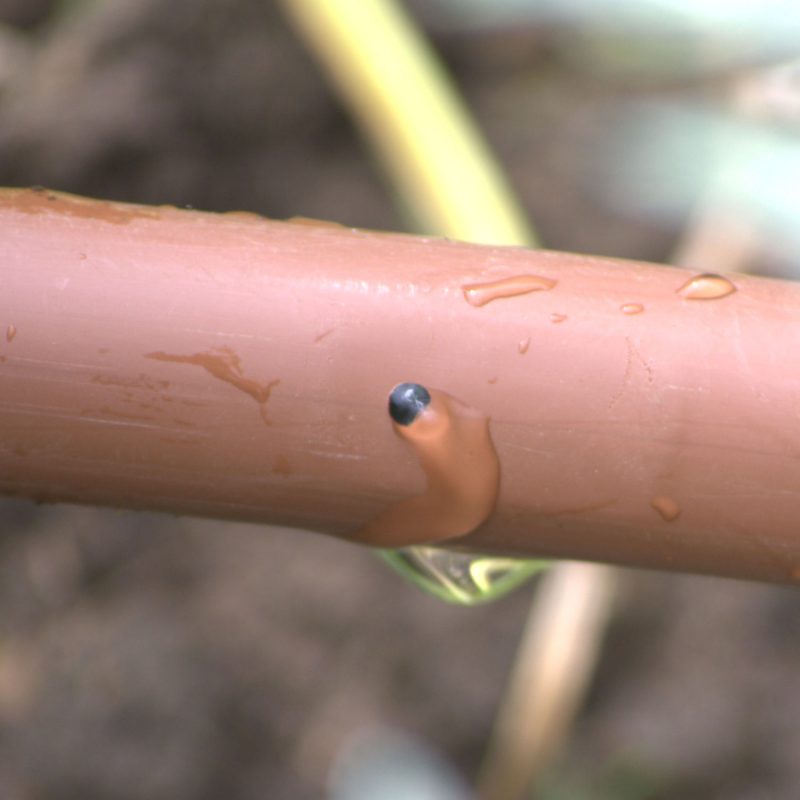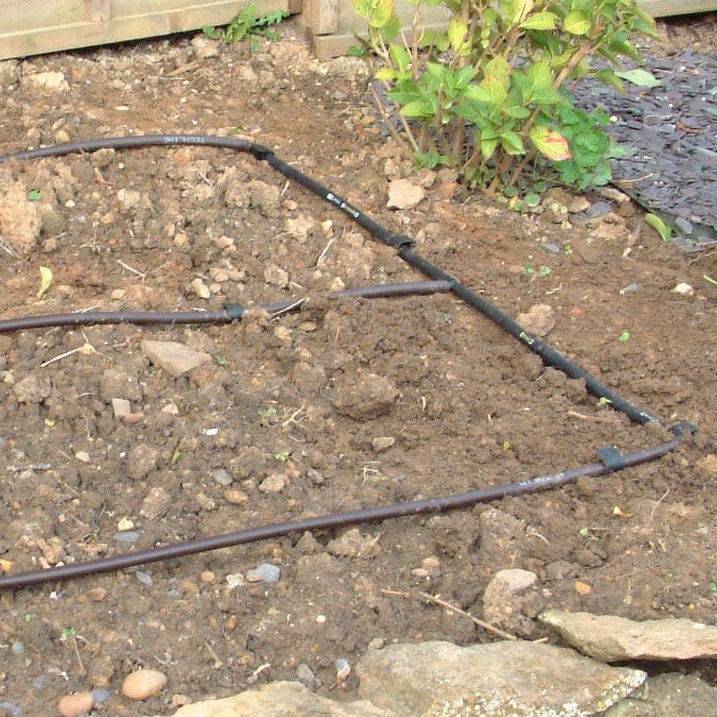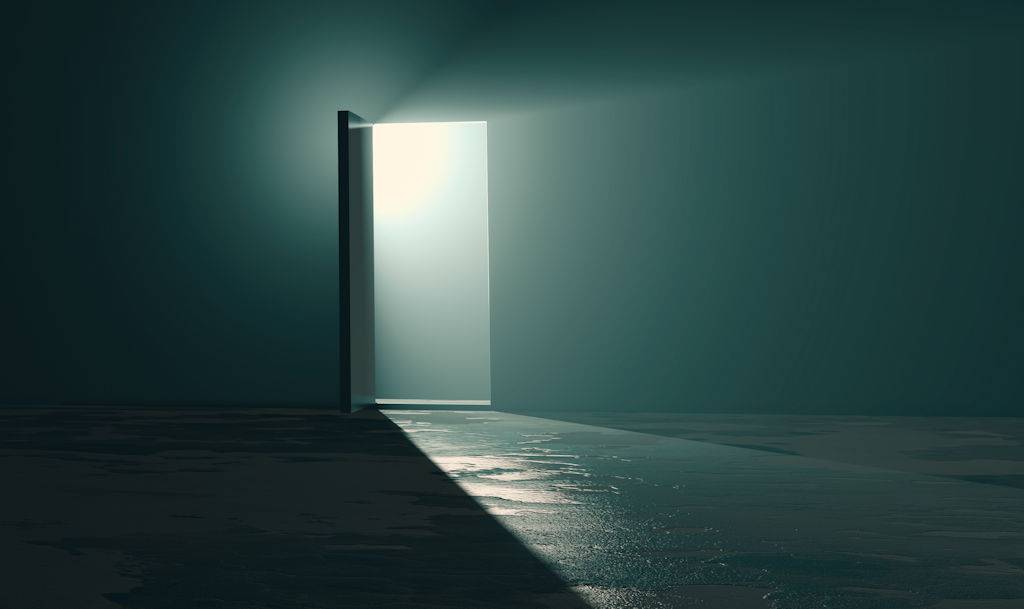What is the difference between soaker hose compared to dripline? In this article we look at soaker hose and the advantages of commercial dripline over porous pipe products.
The phrase soaker hose is commonly used the to describe watering a garden border without using a sprinkler. However, what exactly is a soaker hose and how does it differ from a dripline. More importantly, which is better for watering the borders and shrub beds in the garden?
Soaker hose characteristics
A soaker hose is a porous pipe that is connected to the water supply and laid on the soil. As its name suggests, the wall of the pipe is porous, allowing water to seep out along its entire length; however, how porous the pipe is varies down its length, leading to wetter and drier areas as some parts let more water out and some less water.
Porous pipes have ultra-fine holes in the surface of the pipe which can easily clog over time. Even mains water needs extensive filtration to remove fine particles of sediment and limescale build-up will reduce flow.
Also, due to the simple porous structure, soaker hoses will tend to let out more water at the begging of the run compared to the end of the run. For this reason, soaker hoses only tend to be used in domestic situations as their output is too imprecise for commercial watering applications.
Dripline design and specification
 By contrast, a dripline is manufactured from polythene with individual drippers fitted inside the pipe, with a tiny exit hole on the outside. The dripper spacing can vary between 0.15m apart and 0.5m apart and depending on the manufacturer, the dripline output can very between 1.6 l/h and 2.3 l/h. Drippers can also have features such as pressure compensation and non-leakage. Pressure compensated nozzles overcome variations in pipe pressure by using a flexible diaphragm that opens and closes in response to pressure fluctuations during watering – modern commercial grade dripper nozzles are miniature feats of engineering, ensuring highly uniform output along the entire length.
By contrast, a dripline is manufactured from polythene with individual drippers fitted inside the pipe, with a tiny exit hole on the outside. The dripper spacing can vary between 0.15m apart and 0.5m apart and depending on the manufacturer, the dripline output can very between 1.6 l/h and 2.3 l/h. Drippers can also have features such as pressure compensation and non-leakage. Pressure compensated nozzles overcome variations in pipe pressure by using a flexible diaphragm that opens and closes in response to pressure fluctuations during watering – modern commercial grade dripper nozzles are miniature feats of engineering, ensuring highly uniform output along the entire length.
Many gardeners worry that as driplines have a gap between drippers, the plants between the dripper will be too dry. However, drip irrigation systems work by raising the moisture level in the entire bed – once the water enters the soil structure capillary attraction will move the water laterally as well as vertically, making the whole soil area moist. The root zone of the plant will also spread out from the plant, creating an underground network of roots to access the moisture held within the soil.
Slow watering is good
 A dripline will add water very slowly to the border, typically each dripper will have an output of 1.6 l/h, about the same as a dripping tap. This has a number of advantages:
A dripline will add water very slowly to the border, typically each dripper will have an output of 1.6 l/h, about the same as a dripping tap. This has a number of advantages:
- Minimal run off from the bed
- Large areas can be watered with a small supply
- Sloping sites can be catered for
Typically, the irrigation system needs to replace the moisture lost each day through evapotranspiration. On a hot, dry summers day in England, this will amount to about 4 litres of moisture lost for every m2 of border. A drip line will take around 45 minutes to replace this.
Benefits of Dripline Irrigation
When considering soaker hose compared to dripline, there are a number of advantages of using commercial grade irrigation dripline.
Dry soil surface is an advantage
Counterintuitively, ideally the surface of the bed should be dry. This reduces evaporation losses and also reduces the problem of weed growth. Driplines have an advantage in this respect as unlike soaker hoses, which soak a broad band of soil, the drippers of the dripline concentrate the water into smaller coin-sized patches – once the water has entered the soil it will move laterally to drier areas.
Dripline for longer beds
 As soaker hoses have a high output along their length, they can only be used on shorter runs. Pressure compensated driplines, by contrast, can have run lengths of over 250m, making them ideal for bigger and more complex border irrigation projects.
As soaker hoses have a high output along their length, they can only be used on shorter runs. Pressure compensated driplines, by contrast, can have run lengths of over 250m, making them ideal for bigger and more complex border irrigation projects.
The other problem with soaker hoses is that their water output varies, making it difficult to design an irrigation system. On larger systems the watering will be divided into zones, with a water flow matched to the pump capacity. With a soaker hose this is difficult.
When is a good time to water?
Ideally watering should take place at night when the levels of evaporation are at their lowest. This will also allow time for the moisture to sink into the soil before the heat of the sun. However, if the irrigation system is very large and there is insufficient time to water everything during the night, drip irrigation can take place during the day.
In conclusion, when considering soaker hose compared to dripline, we can see that for for larger garden irrigation systems and systems where even watering is important, commercial grade driplines are far superior to porous pipes.
